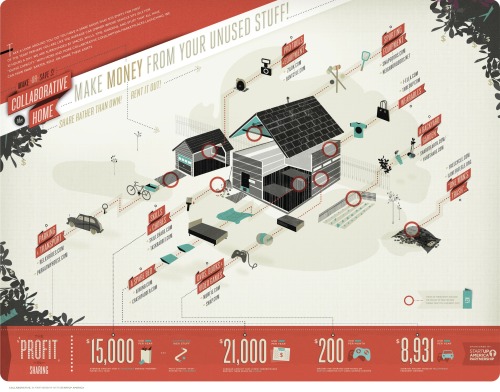Along with interviewing and hanging out in the peer economy, I’ve been reading voraciously since the beginning of the year. The goal of my thesis research is not to publish another version of existing information but to create information that is useful in the world of practice. To understand the landscape, I’ve been reading a lot of literature for context. The first wave of publications and output I’ve explored are by analysts and investors like Rachel Botsman’s What’s Mine is Yours and Lisa Gansky’s The Mesh. Many of their thoughts are echoed by articles in mainstream media beginning to broach the peer economy.

Infographic by Collaborative Fund. Bigger version here.
So welcome to the Cliff Notes version of my reading list. They may use different jargon, but Round One – The peer economy according to investors, analysts and mainstream journalists:
- TRIPLE BOTTOM LINE – The traditional bottom line of a company is profits for its investors. Double bottom line refers to a focus on profits and social responsibility. The triple bottom line means that the company invests in profit returns, social impact and environmental impact. Rachel Botsman’s “collaborative consumption” is a definition that captures this emphasis—instead of creating more output, it’s about reuse. This looks like trading, consignment (think thredUp) or buying something once to be sold hundreds of time (think ZipCar or CitiBike).
- DISRUPTION of traditional business models – Instead of a single entity (i.e. corporation) selling directly to consumers, consumers now turn to each other as vendors and customers.
This affects qualities such as company transparency, marketing and customer service. - SHARING has always existed – In a recent one-hour webinar, analyst and consultant Jeremiah Owyang used Denmark’s King Frederick VII as a throughline. In his time, Europe was going through revolution after revolution, which also meant beheading of royals. Frederick knew that a revolution would soon be on his doorstep, and he had one of two choices: Quash rebellions to maintain the throne and probably get beheaded in the process or give the people governance, step aside and live. For the last 160 years, Denmark has been a popular government and boasts the second oldest monarchy in the world.
Owyang also mentions banks as a system of sharing. Banks co-own our houses, our cars. If we shift our lens, we’ll see that sharing has always existed.
Most of these publications only give passing references to co-ops, tool libraries, free skools, which are predecessor models to digital. Steve Johnson’s Future Perfect explores the peer economy’s heritage, but that’s for another reading notes installment. - SOCIAL CAPITAL for users– The most obvious meaning of this is the social capital within the social network of a peer economy platform. You build a reputation as a buyer or seller. Going beyond this, Lisa Gansky explains that people want access to things, not to own things. If you borrow luxury items from someone else, you enjoy the bragging rights without having to maintain and store those items.
